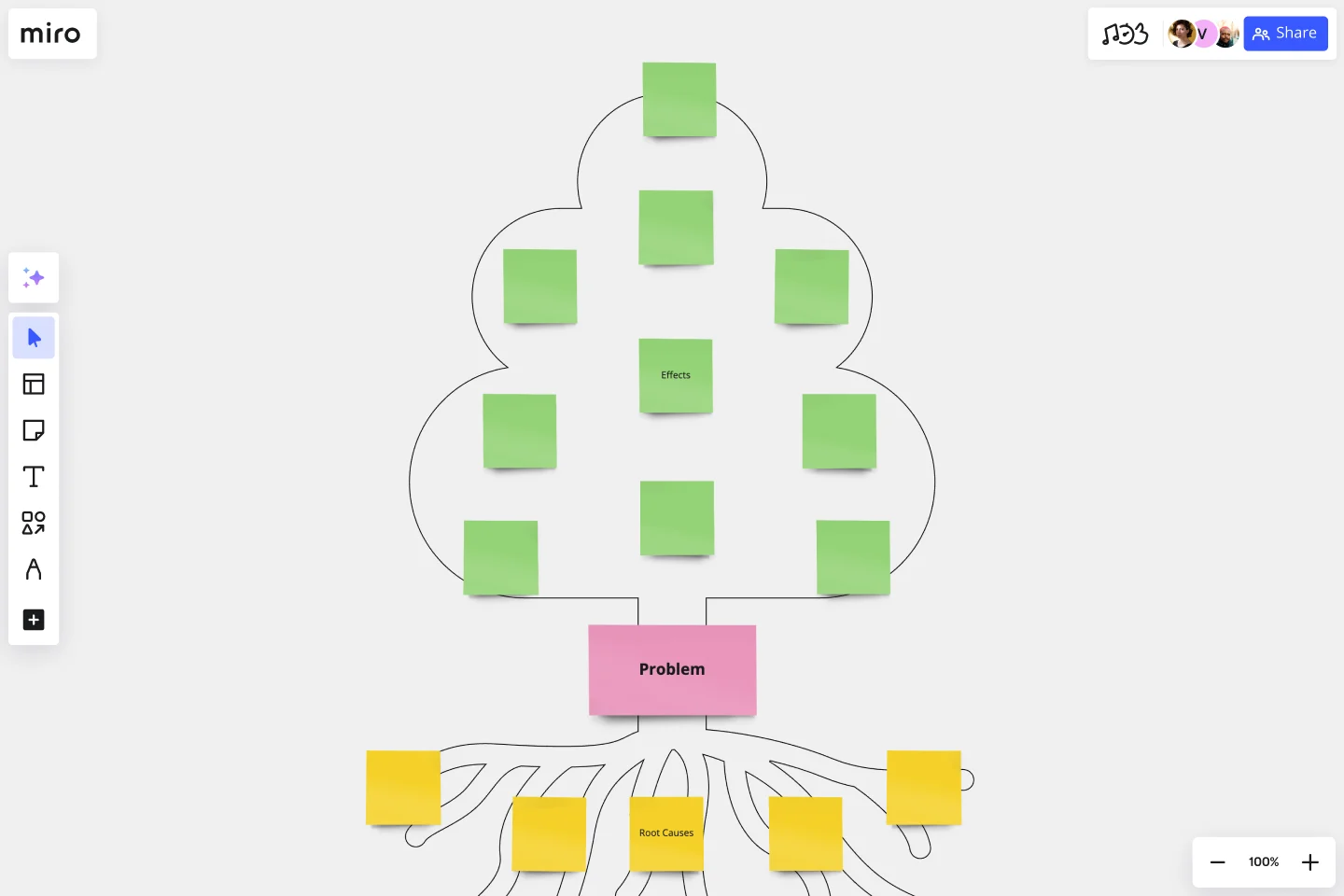Problem Tree Template
Use the Problem Tree Template to promote holistic insights, enabling users to strategize more informed and impactful solutions. This method ensures that efforts are addressing symptoms and targeting the heart of the problem.
About the Problem Tree Template
Dive into the complexities of any issue with the Problem Tree Template. This valuable resource provides a structured approach to problem-solving, helping users identify a problem's root causes and understand its ripple effects. Suitable for challenges in business, community, or personal initiatives, the template offers clarity and a broad perspective on complex issues.
What's a Problem Tree Template?
A Problem Tree Template is a structured visual tool designed to break down a central problem into its main effects and the underlying causes. Envision a tree:
The trunk represents the core problem.
The branches depict its direct effects.
The roots symbolize the deep-seated reasons behind it.
By mapping out the issue in such a detailed way, people and teams can gain a comprehensive view of their challenges. One significant benefit of using this template is that it fosters a holistic understanding of the problem, enabling more strategic and effective solutions. This method helps pinpoint where interventions might be most effective and encourages a more collaborative and inclusive approach to problem-solving.
How to use a Problem Tree Template in Miro
Using the Problem Tree Template in Miro is an interactive experience that brings your problem-solving sessions to life. With the help of sticky notes, emojis, and stickers, you can dynamically populate your tree diagram. Here's how you can do it in four steps:
Identify the central problem: Start by placing a sticky note in the center of your board detailing the main problem you want to tackle. This serves as the trunk of your problem tree.
Map out the effects: Above the central problem, use sticky notes to detail the direct effects or consequences of the problem. Think of these as the branches of your tree. Feel free to use emojis or stickers to add emphasis or to categorize.
Unearth the root causes: Below the central problem, dive deep to uncover the underlying causes of the problem. Use sticky notes for each identified cause, and think of them as the roots of your tree. Emojis and stickers can once again be used to visualize the intensity or type of each cause.
Connect and organize: Finally, draw lines or connectors between related effects and causes, helping to visualize the relationships and flow between different parts of your problem tree.
Learn more about Miro's tree diagram maker and find out other solutions for your decision-making process.
Can I customize the Problem Tree Template?
Yes, Miro allows you to customize any template. Feel free to add more sections and colors or even integrate other templates as needed to tailor the template to your specific needs.
Is this template suitable for group workshops?
Yes, the Problem Tree Template is ideal for group sessions. Multiple users can collaborate in real time, adding their insights and helping to map out a comprehensive view of the problem.
What if my problem has more than one main effect or root cause?
The beauty of the template is its flexibility. You can add as many effects and root causes as necessary to accurately represent your problem. Miro's visual workspace can be expanded indefinitely, so space won't be an issue.
Can I share my completed problem tree with others?
Of course! Miro allows you to easily share your boards with team members, stakeholders, or anyone else. They can then view or collaborate on your problem tree, depending on the permissions you grant.
Get started with this template right now.
Objectives and Key Results (OKRs) Template
Works best for:
Leadership, Strategic Planning, Project Planning
Clarity, focus, and structure — those are the key ingredients to feeling confident in your company’s directions and decisions, and an OKR framework is designed to give them to you. Working on two main levels — strategic and operational — OKRs (short for objectives and key results) help an organization’s leaders determine the strategic objectives and define quarterly key results, which are then connected to initiatives. That’s how OKRs empower teams to focus on solving the most pressing organizational problems they face.
Fishbone Diagram for Healthcare
Works best for:
Fishbone Diagram
Ensuring high-quality care in healthcare settings requires a thorough understanding of root causes behind issues. The Fishbone Diagram for Healthcare template helps you analyze potential causes of problems in areas like patient care, staff performance, and administrative processes. This structured approach facilitates comprehensive analysis and collaborative problem-solving, ultimately leading to improved healthcare outcomes and patient satisfaction.
Product Development Gantt Chart
Works best for:
Gantt Chart, Planning
Developing a new product involves many steps and stakeholders. The Product Development Gantt Chart template helps you manage this complex process efficiently. Use it to outline each phase of development, set timelines, and assign responsibilities. Track progress and make adjustments as needed to stay on schedule. This template provides a clear visual representation, coordinating tasks for a successful product launch.
Timeline-Retrospective
Works best for:
Timeline, Planning
Use the Timeline Retrospective template to review project progress and outcomes. It’s ideal for identifying what worked well and what didn’t, facilitating continuous improvement. This template helps teams reflect on their performance and make informed decisions for future projects.
Gantt Chart for Project Scheduling
Works best for:
Planning, Strategy
Gantt Chart for Project Scheduling helps you plan and visualize project timelines. It enables you to manage tasks, deadlines, and dependencies, ensuring efficient project execution. Ideal for project managers looking to streamline their scheduling process.
Fishbone Diagram for Marketing
Works best for:
Fishbone diagram
Identifying the root causes of marketing challenges is essential for effective strategy development. The Fishbone Diagram for Marketing template helps you systematically explore factors affecting your marketing efforts. Categorize potential causes into areas such as market research, product positioning, promotional strategies, and distribution channels. This structured analysis enables your team to pinpoint and address issues, optimizing marketing campaigns.
